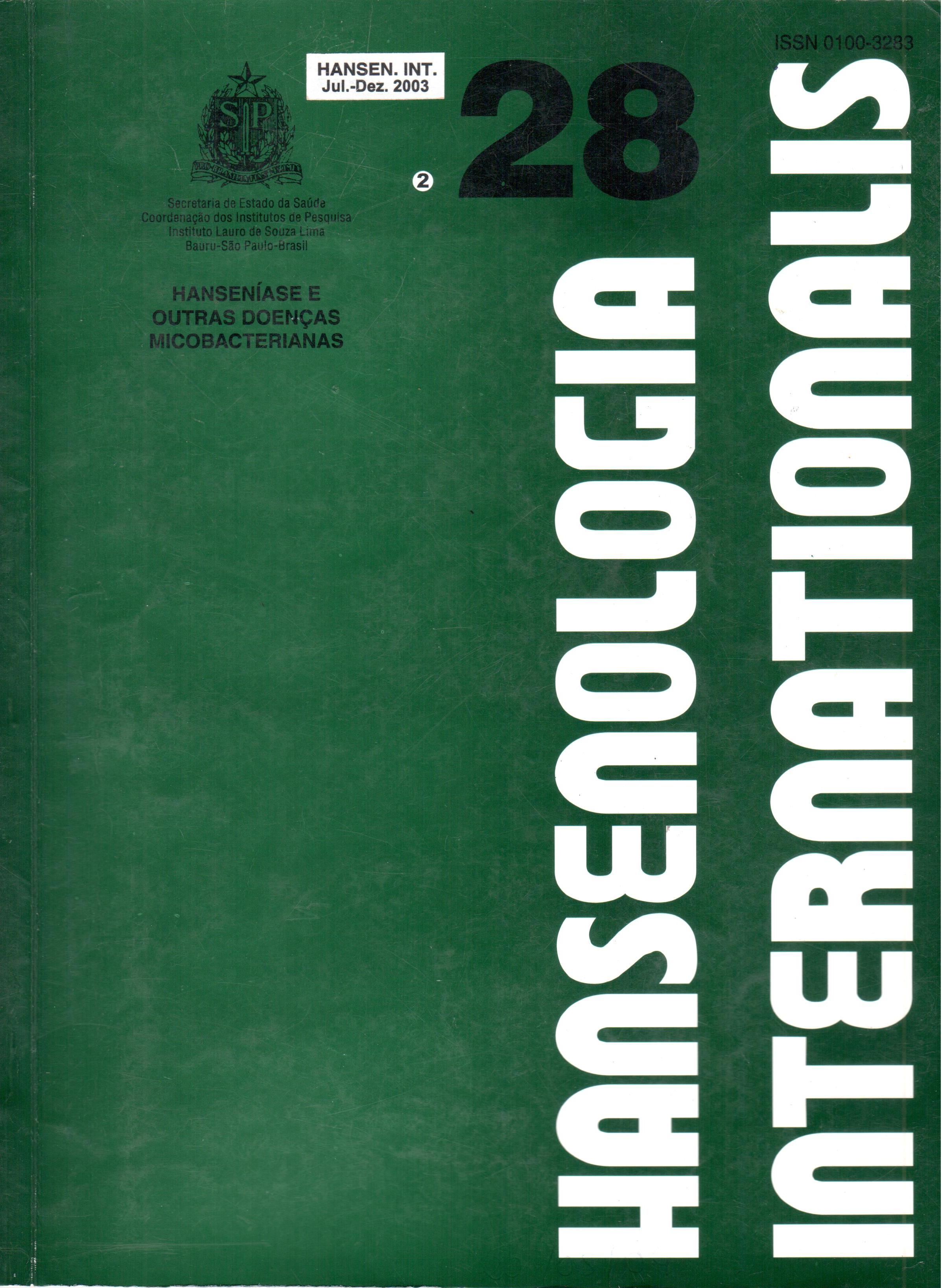Abstract
Introduction and purpose: Some authors demonstrated the possibility of the armadillos, Dasypus novemcinctus, being an environmental source of Mycobacterium leprae. An epidemiologic survey was done to check the correlation between the human contact with armadillos and the incidence
of leprosy. It discusses some features that could be involved in the dynamic process of the leprosy development. The objective of this research is to check the frequency of cases of leprosy contacts with armadillos and also the interhuman contact before their diagnosis to establish the possibility of the M. leprae transmission to the human being through the contact with armadillos. Methods: One hundred and seven leprosy patients were surveyed (leprosy patients that had finished the MDT treatment) who lived in the Pedro Fontes Colony-Hospital, in Cariacica, Espirito Santo State, Brazil, 29 leprosy patients and 173 non leprosy patients from a dermatology service of the city of Vitória, Brazil. The survey included data about the armadillo meat consumption before leprosy diagnosis, the existence of known cases and/or familial leprosy cases. The data were analyzed by Qui-square test, correlation and Exact Fischer Test. Results: 90.4% of the leprosy patients or cured leprosy patients had once eaten armadillo meat before their leprosy diagnosis, while 15% of the non leprosy patients had already eaten armadillo meat. In a group without leprosy contact before the diagnosis, 96,1% ate armadillo meat, and 3,9% didn't eat. This study supposes a possible source of the M. leprae by the armadillo meat consumption, mainly, in a leprosy patients without previous leprosy contact.
References
2. BRUCE, S.; SCHROEDER, T. L.; KENNETH, E.; HOWARD, R.; WILLIANS, T.; WOLF, J. E. Armadillo exposure and Hansen’s disease: An epidemiologic survey in southern Texas. J. Am. Acad. Dermatol., v. 43, n. 2, p. 223-228, 2000.
3. DEPS, P. D.; SANTOS, A. R.; TOMIMORI-YAMASHITA, J. Detection of Mycobacterium leprae DNA by PCR in blood sample from nine-banded armadillo: preliminary results (letter). Int. J. Lepr, v. 70, n. 1, p. 34-35, 2002.
4. DEPS, P. D. Pesquisa de Mycobacterium leprae em tatus da espécie Dasypus novemcinctus do Estado do Espírito Santo. São Paulo, 2003. Tese (Doutorado). Universidade Federal de São Paulo, 145 p.
5. DESIKAN, K. V.; SREEVATSA. Extended studies on the viability of Mycobacterium leprae outside the human body. Lepr. Rev., v. 66, p. 287, 1995.
6. DHOPLE, A. L. Armadillo as a model for studying chemotherapy of Leprosy. Indian J. Leprosy, v. 58, n. 1, p. 19-28, 1986.
7. ENNA, C. D.; JACOBSON, R. R.; TRAUTMAN, J. R.; STUTDIVANT, M. Leprosy in the United States (1967- 1976). Public. Health Rep., v. 93, p. 468-473, 1978.
8. JOB, C. K. Leprosy- the source of infection and its mode of transmission. Lepr. Rev., v. 52, n. 1, p. 69-76, 1981.
9. JOSEPH, B. Z.; YODER, L. J.; JACOBSON, R. R. Hansen’s disease in native-born citizen of the United States. Public. Health Rep., v. 100, p. 666-71, 1985.
10. KHANOLKAR, V. R. Perspective in pathology of leprosy. Indian J. Med. Sci. v. 9, n. 1, p. 1-44, 1955.
11. LECHAT, M. F. The paleoepidemiology of leprosy: an overview. Int. J. Lepr., v. 67, n. 4, p. 460-470, 1999.
12. LEIKER, D. L. On the mode of transmission of Mycobacterium leprae. Lepr. Rev. v. 48, p. 9, 1977.
13. MATSUOKA, M.; IZUMI, S.; BUDIAWAN, T.; NAKATA, N.; SAEKI, K. Mycobacterium leprae DNA in daily using water as a possible source of leprosy infection. Indian. J. Lepr. v. 71, n. 1, p. 61-67, 1999.
14. MEYERS, M. W. Leprosy. In: GUERRANT R. L., WALKER, D. H., WELLER, P. F. Tropical Infectious Diseases. Principles, Pathogens, & Pratice. Philadelphia: Churchill Livingstone, p. 474-484, 1999.
15. RESOAGLI, E.; MARTÍNEZ, E.; RESOAGLI, J. Comunicación de un caso mycobacteriosis esplénica natural en el armadillo com características histopatológicas y tintoriales similares a lepra. Leprologia, p.21, 1979.
16. RODRIGUES, S.; BERACO, E.; KOIZUMI, F.; ALCHORNE, M. M. A. Tatu e hanseníase. An. Bras. Dermatol., v. 68, n. 6, p. 340-345, 1993.
17. SHIN, Y. C.; LEE, H.; LEE, H.; WALSH, G. P.; KIM, J. D.; CHO, S. N. Variable numbers of TTC repeats in Mycobacterium leprae DNA from leprosy patients and use in strain differentiation. J. Clin. Microbiol., v. 38, n. 12, p. 4535-4538, 2000.
18. SMITH, J. H.; FILE, S. K.; NAGY, B. A.; FOLSE, D. S.; BUCKNER, J. A.; WEBB, L. J.; BEVERDING, A. M. Leprosy-like disease of wild armadillos in French Acadiana, Louisiana. J. Reticuloendothel. Soc., v. 24, p. 705, 1978.
19. SOTO, C. Y.; MORENO, P. A.; VALENCIA, J. T.; BERNAL, M. M.; GUZMAN, F.; PATORROYO, M. E.; MURILLO, L. A. Isolation, characterization, molecular cloning and amplification of the speciesspecific M. leprae antigen. Int. J. Lepr., v. 67, n. 4, p. 392-402, 1999.
20. STORRS, E. The nine-banded armadillo: A model for leprosy and other biomedical research. Int. J. Lepr, v. 39, n. 3, p. 703-714, 1971.
21. TAYLOR, C. E.; ELLISTON, E. P.; GIDEON, H. Asymtomatic infections in leprosy. Int. J. Lepr., v. 33, p. 716-31, 1965.
22. VENTURINI, A. C.; OFRANTI, A. M. S.; VAREJÃO, J. B. M.; PAZ, P. R. Aves e mamíferos na restinga. Secretaria do Estado de Desenvolvimento Sustentável – SEDESU, p. 76, 1996.
23. WALSH, G. P.; STORRS, E. E.; BURCHFIELD, H. P.; VIDRINE, M. F.; BINFORD, C. H. Leprosy-like disease occurring naturally in armadillos. J. Reticul. Soc., v. 18, p. 347-51, 1975.
24. WALSH, G. P.; STORRS, E. E.; MEYERS, W.; BINFORD, C. H. Naturally acquired leprosy-like disease in the nine-banded armadillo (Dasypus novemcinctus): recent epizootiologic findings. J. Reticuloendothel. Soc., v. 22, p. 363-7, 1977.
25. WALSH, G. P.; MEYERS, W. M.; BINFORD, C. H.; GEROME, P. J.; WOLF, R. H.; LEININGER, J. R. Leprosy – a zoonosis. Lepr. Rev., v. 52, s. 1, p. 77-83, 1981.
26. WIDDOUSON, T. W. Special or dental anatomy and physiology and dental histology. 7ed. London, Staples Printers, p. 332, 1946.

This work is licensed under a Creative Commons Attribution 4.0 International License.
